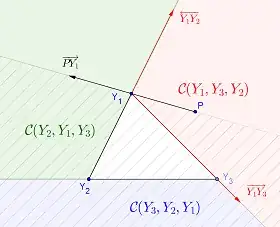Given any three distinct points $A, B, C$, let
- $\overrightarrow{AB}$ be the ray starting from $A$ pointing towards $B$.
- $\overleftarrow{AC}$ be the ray starting from $A$ pointing away from $C$.
- $\mathcal{C}(A,B,C)$ be the cone obtained by rotating a ray start from $\overrightarrow{AB}$ to $\overleftarrow{AC}$ counterclockwisely.
- $\mathcal{H}(A,B) = \mathcal{C}(A,B,B)$ be the half-space on the "left hand" side of the ray $\overrightarrow{AB}$.
Given any fixed point $P = (x_P,y_P)$ and three random points $X_1, X_2, X_3$ sampled from a continuous distribution. Aside from events of probability zero, the four points $P, X_1, X_2, X_3$ will be in general position. i.e. no three of them will be colinear.
Let $Y_1, Y_2, Y_3$ be a reordering of the $X_1, X_2, X_3$ so that $Y_1, Y_2, Y_3$ surrounds the triangle $\triangle_{X_1X_2X_3}$ in counterclockwise manner.
There are four mutually exclusive possibilities for the position of $P$ relative to $Y_1, Y_2, Y_3$. $P$ can lie in the interior of
triangle $\triangle_{Y_1Y_2Y_3}$ or interior of one the cones
$\color{red}{\mathcal{C}(Y_1,Y_3,Y_2)}, \color{green}{\mathcal{C}(Y_2,Y_1,Y_3)}$ and $\color{blue}{\mathcal{C}(Y_3,Y_2,Y_1)}$.
$\hspace{1in}$ 
There is a simple criterion to test whether $P$ belongs to one of the cones.
As one can see from above diagram, $P \in \mathcal{C}(Y_1,Y_3,Y_2)$ is more or less equivalent to both $Y_2,Y_3$ lie at "left hand" side of ray $\overrightarrow{PY_1}$ (the hatched area in above diagram ). This happens to the other two cones. Aside from events of probability zero, we have
$$
\begin{align}
P \in \mathcal{C}(Y_1,Y_3,Y_2)\quad\iff\quad Y_2,Y_3 \in \mathcal{H}(P,Y_1)\\
P \in \mathcal{C}(Y_2,Y_1,Y_3)\quad\iff\quad Y_3,Y_1 \in \mathcal{H}(P,Y_2)\\
P \in \mathcal{C}(Y_3,Y_2,Y_1)\quad\iff\quad Y_1,Y_2 \in \mathcal{H}(P,Y_3)
\end{align}
$$
Using symmetry and the fact $X_1, X_2, X_3$ are $iid$ from same continuous distribution, we have
$$
\mathbb{P}\left[P \in \triangle_{X_1X_2X_3}\right]
= 1 - 3\mathbb{P}\left[ Y_2,Y_3 \in \mathcal{H}(P,Y_1) \right]
= 1 - 3\mathbb{E}\left[ \mathbb{P}\left[ X_2 \in \mathcal{H}(P,X_1) | X_1 \right]^2 \right]$$
This leads to following integral representation of the desired probability
$$\mathbb{P}\left[P \in \triangle_{X_1X_2X_3}\right]
= 1 - 3\int_{0}^{2\pi} \rho(P,\theta)
\left[ \int_{\theta}^{\theta+\pi}\rho(P,\phi)d\phi \right]^2 d\theta
$$
where
$$\rho(P,\theta)\stackrel{def}{=} \int_{0}^{\infty}F(x_P+r\cos\theta,y_P+r\sin\theta) rdr$$
is the probability density function for ray $\overrightarrow{PX_1}$ making an angle $\theta$ with respect to the $x$-axis.
There is an interesting special case.
When $F(x,y)$ is centrally symmetric with respect to $P$,
$$\mathbb{E}\left[X_2 \in \mathcal{H}(P,X_1) | X_1\right]
= \int_{\theta}^{\theta+\pi} \rho(P,\phi)d\phi =
\frac12$$
independent of $\theta$. In that case, we have
$$\mathbb{P}\left[P \in \triangle_{X_1X_2X_3}\right] = 1 - 3\left(\frac12\right)^2 = \frac14
$$
